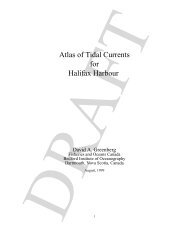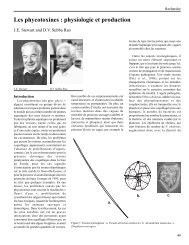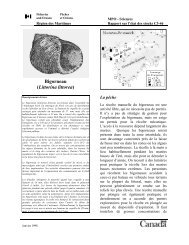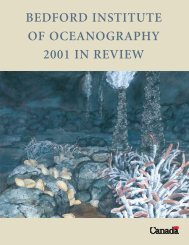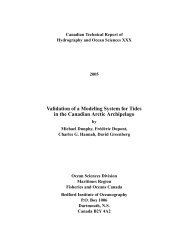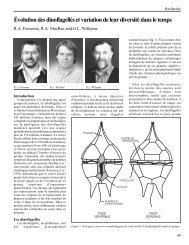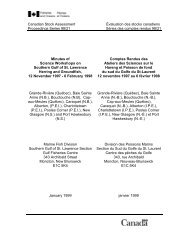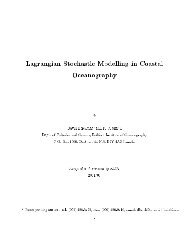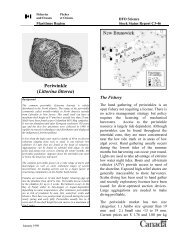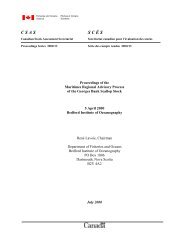Clam Enhancement Trials in the Bay of Fundy
Clam Enhancement Trials in the Bay of Fundy
Clam Enhancement Trials in the Bay of Fundy
Create successful ePaper yourself
Turn your PDF publications into a flip-book with our unique Google optimized e-Paper software.
Research<br />
<strong>Clam</strong> <strong>Enhancement</strong> <strong>Trials</strong> <strong>in</strong> <strong>the</strong> <strong>Bay</strong> <strong>of</strong> <strong>Fundy</strong><br />
S.M.C. Rob<strong>in</strong>son<br />
Land<strong>in</strong>gs (t)<br />
12,000<br />
10,000<br />
8,000<br />
6,000<br />
S<strong>of</strong>t-shell <strong>Clam</strong>s - <strong>Bay</strong> <strong>of</strong> <strong>Fundy</strong><br />
Nova Scotia<br />
New Brunswick<br />
4,000<br />
2,000<br />
S.M.C. Rob<strong>in</strong>son<br />
0<br />
1881 1891 1901 1911 1921 1931 1941 1951 1961 1971 1981 1991<br />
Figure 1: Long-term land<strong>in</strong>g records for <strong>the</strong> s<strong>of</strong>t-shell clam <strong>in</strong> <strong>the</strong> <strong>Bay</strong> <strong>of</strong> <strong>Fundy</strong>.<br />
Introduction<br />
History<br />
The clam fishery for <strong>the</strong> s<strong>of</strong>t-shell clam,<br />
Mya arenaria, <strong>in</strong> <strong>the</strong> Canadian Maritimes<br />
has had a long history with formal catch<br />
records dat<strong>in</strong>g back to <strong>the</strong> late 1800s. This<br />
species was probably one <strong>of</strong> <strong>the</strong> first mar<strong>in</strong>e<br />
species to be exploited due to its relatively<br />
easy access dur<strong>in</strong>g low tides. The<br />
s<strong>of</strong>t-shell clam was an important food<br />
source for <strong>the</strong> native tribes <strong>in</strong> <strong>the</strong> area who<br />
harvested <strong>the</strong>m extensively for food and <strong>the</strong><br />
rema<strong>in</strong>s <strong>of</strong> this early exploitation can be<br />
seen from <strong>the</strong> many shell mounds or<br />
“middens” <strong>in</strong> <strong>the</strong> area. After colonisation<br />
by <strong>the</strong> Europeans, clams cont<strong>in</strong>ued as a<br />
basis for <strong>the</strong> food <strong>in</strong>dustry, first as a direct<br />
food source and later as a bait source for<br />
<strong>the</strong> lucrative long-l<strong>in</strong>e fishery <strong>of</strong>f <strong>the</strong> Grand<br />
Banks and o<strong>the</strong>r groundfish<strong>in</strong>g areas. At<br />
<strong>the</strong> turn <strong>of</strong> <strong>the</strong> century, fish<strong>in</strong>g schooners<br />
would <strong>of</strong>ten stop <strong>of</strong>f <strong>in</strong> <strong>the</strong> Annapolis Bas<strong>in</strong><br />
or <strong>the</strong> Quoddy region <strong>in</strong> south-western<br />
New Brunswick to ga<strong>the</strong>r barrels <strong>of</strong> salted<br />
clams for bait. Much <strong>of</strong> this harvest was<br />
very likely unrecorded. In <strong>the</strong> early to mid<br />
1900s, a cann<strong>in</strong>g <strong>in</strong>dustry for clams was<br />
well established and many clams were exported<br />
<strong>in</strong> this form from <strong>the</strong> <strong>Bay</strong> <strong>of</strong> <strong>Fundy</strong>.<br />
Recent Past<br />
Harvest<strong>in</strong>g methods have changed very<br />
little over <strong>the</strong> last century with respect to<br />
harvest<strong>in</strong>g technology. With <strong>the</strong> exception<br />
<strong>of</strong> a brief period <strong>in</strong> <strong>the</strong> 1960s when automated<br />
harvest<strong>in</strong>g techniques were exam-<br />
67
Research<br />
Method Concept Pros Cons<br />
Rotational Digg<strong>in</strong>g<br />
Brush<strong>in</strong>g<br />
Relay<strong>in</strong>g<br />
Harvest <strong>the</strong> clam flats on<br />
a rational basis <strong>in</strong> order<br />
to allow certa<strong>in</strong> flats to<br />
lie fallow and become<br />
more productive.<br />
Place artificial barriers<br />
on <strong>the</strong> beach <strong>in</strong> order to<br />
<strong>in</strong>crease <strong>the</strong> rate <strong>of</strong><br />
natural spat settlement<br />
and survival.<br />
Move juvenile clams for<br />
fur<strong>the</strong>r growout from a<br />
high density beach to<br />
one that has been<br />
depleted through<br />
harvest<strong>in</strong>g pressure.<br />
Table 1: Summary <strong>of</strong> <strong>the</strong> pros and cons <strong>of</strong> <strong>the</strong> three enhancement methods tested <strong>in</strong> south-western<br />
New Brunswick.<br />
<strong>in</strong>ed, hand harvest<strong>in</strong>g us<strong>in</strong>g a clam fork<br />
(hack or digger) is still <strong>the</strong> only method<br />
used <strong>in</strong> <strong>the</strong> <strong>Bay</strong> <strong>of</strong> <strong>Fundy</strong>. However, while<br />
<strong>the</strong> harvest<strong>in</strong>g methods have not changed,<br />
<strong>the</strong> land<strong>in</strong>gs have generally decreased (Fig.<br />
1). While some <strong>of</strong> <strong>the</strong> drops <strong>in</strong> land<strong>in</strong>gs may<br />
be due to social conditions at <strong>the</strong> time (i.e.<br />
World War II) and biological events and<br />
cycles, <strong>the</strong> trend <strong>of</strong> decrease is correct. This<br />
drop <strong>in</strong> land<strong>in</strong>gs has had a dramatic effect<br />
on <strong>the</strong> local economies. Although <strong>the</strong> loss<br />
to <strong>the</strong> communities can not be directly estimated,<br />
we can derive an <strong>in</strong>direct estimate.<br />
If we assume that <strong>the</strong> beaches still have <strong>the</strong><br />
capacity to support <strong>the</strong> production levels<br />
<strong>of</strong> <strong>the</strong> past, <strong>the</strong>n <strong>the</strong> 10 year average land<strong>in</strong>gs<br />
<strong>of</strong> <strong>the</strong> <strong>Bay</strong> <strong>of</strong> <strong>Fundy</strong> was approximately<br />
5,700 tons from 1945 to 1955. If<br />
this biomass <strong>of</strong> clams was landed today and<br />
sold for <strong>the</strong> current price <strong>of</strong> $1.90/ kg<br />
($0.85/lb), this would net <strong>the</strong> diggers and<br />
local economies about $10.86 million. In<br />
1994, <strong>the</strong> total recorded land<strong>in</strong>gs amounted<br />
to 1191 tons which was worth $2.27 million<br />
at $1.90/ kg, a drop <strong>of</strong> 80 %. This loss<br />
<strong>in</strong> potential annual <strong>in</strong>come is significant to<br />
<strong>the</strong> clam <strong>in</strong>dustry. Many <strong>of</strong> its participants<br />
work <strong>in</strong> several primary <strong>in</strong>dustry sectors<br />
(agriculture, forestry, fish<strong>in</strong>g) over <strong>the</strong><br />
course <strong>of</strong> <strong>the</strong> year and while <strong>the</strong>ir annual<br />
<strong>in</strong>come may not be great, each portion is<br />
• allows clams to get a<br />
few years <strong>of</strong> relief from<br />
digg<strong>in</strong>g pressure<br />
• results <strong>in</strong> better growth<br />
and lower mortality<br />
• relatively easy<br />
management method<br />
• natural method <strong>of</strong><br />
<strong>in</strong>creas<strong>in</strong>g natural<br />
settlement<br />
• low-tech and relatively<br />
<strong>in</strong>expensive<br />
• allows over-harvested<br />
areas to be restocked<br />
• high-density<br />
populations can be<br />
th<strong>in</strong>ned for better<br />
growth<br />
• may allow closed areas<br />
to be put back <strong>in</strong>to<br />
production<br />
• can be l<strong>in</strong>ked <strong>in</strong>to a<br />
seed/hatchery system<br />
• problems arise if <strong>the</strong>re<br />
are not enough digg<strong>in</strong>g<br />
areas to set aside<br />
• assumes that <strong>the</strong> areas<br />
closed for conservation<br />
will not be lost to<br />
pollution<br />
• dependent on natural<br />
sources <strong>of</strong> larvae<br />
• very dependent on<br />
growth and survival<br />
rates<br />
• labour <strong>in</strong>tensive for<br />
large areas<br />
• requires a shift <strong>in</strong><br />
management towards<br />
an ownership-based<br />
management style<br />
• very dependent on<br />
growth and survival<br />
rates<br />
• labour <strong>in</strong>tensive<br />
• requires a shift <strong>in</strong><br />
management towards<br />
an ownership-based<br />
management style<br />
important. In addition, <strong>the</strong> overhead expenses<br />
related to harvest<strong>in</strong>g is small so <strong>the</strong><br />
bulk <strong>of</strong> <strong>the</strong> earn<strong>in</strong>gs go directly back <strong>in</strong>to<br />
<strong>the</strong> economy ra<strong>the</strong>r than servic<strong>in</strong>g fish<strong>in</strong>grelated<br />
debt.<br />
The reasons for <strong>the</strong> drop are many, but<br />
<strong>the</strong> primary one is <strong>the</strong> loss <strong>of</strong> many harvest<strong>in</strong>g<br />
areas due to health-related closures<br />
from coliform bacteria. These closures<br />
have a two-fold effect on <strong>the</strong> fishery. First,<br />
it removes <strong>the</strong> clams from <strong>the</strong> wild harvest<strong>in</strong>g<br />
base (although depuration plants<br />
can use moderately contam<strong>in</strong>ated areas)<br />
and it concentrates <strong>the</strong> diggers on <strong>the</strong> o<strong>the</strong>r<br />
open flats. At some po<strong>in</strong>t, depend<strong>in</strong>g on<br />
<strong>the</strong> size and productivity <strong>of</strong> <strong>the</strong> open<br />
beaches, this concentration <strong>of</strong> fish<strong>in</strong>g effort<br />
can over-harvest <strong>the</strong> clam populations.<br />
O<strong>the</strong>r factors which affect <strong>the</strong> productivity<br />
<strong>of</strong> beaches for harvest<strong>in</strong>g are: <strong>the</strong> occurrence<br />
<strong>of</strong> phytotox<strong>in</strong>s (such as paralytic<br />
shellfish poison (PSP), diarretic shellfish<br />
poison (DSP) and domoic acid or amnesiac<br />
shellfish poison (ASP)) or normal<br />
changes <strong>in</strong> biological cycles <strong>in</strong> response to<br />
environmental changes (i.e. cool<strong>in</strong>g or<br />
warm<strong>in</strong>g trends). However, <strong>the</strong>se latter<br />
conditions are temporary and only affect<br />
<strong>the</strong> clam production for fixed time periods.<br />
In comparison, <strong>the</strong> loss <strong>of</strong> clam flats to <strong>the</strong><br />
wild harvesters due to faecal colifom<br />
contam<strong>in</strong>ation will likely be permanent<br />
unless remediation measures are taken.<br />
Objective<br />
The objective <strong>of</strong> our enhancement work<br />
was to <strong>in</strong>vestigate techniques to <strong>in</strong>crease<br />
<strong>the</strong> productivity <strong>of</strong> <strong>the</strong> open beaches <strong>in</strong> order<br />
to susta<strong>in</strong> <strong>the</strong> wild harvest dur<strong>in</strong>g <strong>the</strong><br />
<strong>in</strong>terim period while remediation techniques<br />
are be<strong>in</strong>g developed to clean up <strong>the</strong><br />
coastal zone. Remediation is <strong>the</strong> ultimate<br />
goal as it will not matter about <strong>the</strong> production<br />
capacity <strong>of</strong> a beach if <strong>the</strong> product is<br />
unable to be harvested. The projects were<br />
all designed <strong>in</strong> conjunction with <strong>in</strong>dustry<br />
partners <strong>in</strong> order to achieve direct technology<br />
transfer and easier acceptance <strong>of</strong> <strong>the</strong><br />
results.<br />
Three basic methods were <strong>in</strong>vestigated:<br />
rotational digg<strong>in</strong>g, brush<strong>in</strong>g and relay<strong>in</strong>g<br />
(Table 1). These techniques are not new<br />
and are basically modifications <strong>of</strong> projects<br />
attempted by <strong>in</strong>dustry <strong>in</strong> <strong>the</strong> New England<br />
areas <strong>in</strong> <strong>the</strong> 1950s.<br />
Rotational Digg<strong>in</strong>g<br />
A project to <strong>in</strong>vestigate <strong>the</strong> potential for<br />
rotational digg<strong>in</strong>g was <strong>in</strong>itiated <strong>in</strong> Lepreau<br />
Harbour <strong>in</strong> <strong>the</strong> spr<strong>in</strong>g <strong>of</strong> 1991. Two 3 x 9<br />
m plots on a commercially harvested clam<br />
beach were established and subdivided <strong>in</strong>to<br />
three equal sections; one scheduled to be<br />
harvested on an annual basis (1992, 1993,<br />
1994, 1995)), one on a biennial basis (1993,<br />
1995) and <strong>the</strong> third on a triennial basis<br />
(1994). All plots were completely harvested<br />
on <strong>in</strong>itiation <strong>of</strong> <strong>the</strong> project (1991)<br />
by commercial diggers us<strong>in</strong>g clam forks.<br />
The same diggers harvested <strong>the</strong> plots <strong>in</strong><br />
1992 and 1993. Unfortunately, o<strong>the</strong>r com-<br />
Total Harvest (Kg)<br />
14<br />
12<br />
10<br />
8<br />
6<br />
4<br />
2<br />
0<br />
1991<br />
1993<br />
Annual<br />
Biennial<br />
Harvest Frequency<br />
Figure 2: Total weight <strong>of</strong> clams harvested<br />
from <strong>the</strong> annual (2 harvests) and <strong>the</strong> biennial<br />
plots (1 harvest) between 1991 and 1993. The<br />
<strong>in</strong>itial harvests <strong>in</strong> 1991 from each <strong>of</strong> <strong>the</strong> plots<br />
are shown so <strong>the</strong> dark bars represent <strong>the</strong> new<br />
production from <strong>the</strong> plots from 1991 to 1993.<br />
68
Research<br />
Number <strong>of</strong> <strong>Clam</strong>s<br />
50<br />
40<br />
30<br />
20<br />
10<br />
May-92<br />
Mar-91<br />
0<br />
25 31 37 43 49 55 61 67 73 79 85<br />
Size Class (mm)<br />
Figure 3: Comparison <strong>of</strong> <strong>the</strong> size-frequency distribution between <strong>the</strong> orig<strong>in</strong>al harvest <strong>of</strong> <strong>the</strong><br />
rotational plots <strong>in</strong> 1991 vs. <strong>the</strong> first annual harvest <strong>in</strong> 1992.<br />
mercial diggers dug through <strong>the</strong> plots <strong>in</strong><br />
early 1994 <strong>in</strong>validat<strong>in</strong>g <strong>the</strong> rema<strong>in</strong>der <strong>of</strong> <strong>the</strong><br />
study (i.e. test<strong>in</strong>g <strong>the</strong> benefits <strong>of</strong> triennial<br />
harvest<strong>in</strong>g). The clams from each harvest<strong>in</strong>g<br />
were taken back to <strong>the</strong> laboratory at <strong>the</strong><br />
St. Andrews Biological Station and all were<br />
measured us<strong>in</strong>g calipers and weighed to <strong>the</strong><br />
nearest gram.<br />
The results from <strong>the</strong> first two years <strong>of</strong><br />
study <strong>in</strong>dicated <strong>the</strong>re were advantages to<br />
allow<strong>in</strong>g <strong>the</strong> plots to lie fallow for a year<br />
(Fig. 2). Initially, both <strong>the</strong> annual and biennial<br />
plots had similar harvested<br />
biomass <strong>of</strong> clams, 7.5 vs. 7.3 kg respectively,<br />
while at <strong>the</strong> end <strong>of</strong> <strong>the</strong> 2 year trials<br />
<strong>the</strong> biennial plots had approximately 6.5 %<br />
more harvested biomass. These results <strong>in</strong>dicate<br />
that while <strong>the</strong> total amount harvested<br />
was slightly more <strong>in</strong> <strong>the</strong> biennial plots, <strong>the</strong><br />
catch-per-unit-effort (CPUE) was over double<br />
that <strong>of</strong> <strong>the</strong> annual plots (13.9 kg/digg<strong>in</strong>g<br />
vs. 6.5 kg/digg<strong>in</strong>g). A comparison <strong>of</strong><br />
<strong>the</strong> size frequency distribution between <strong>the</strong><br />
<strong>in</strong>itial harvest and <strong>the</strong> first harvest <strong>of</strong> <strong>the</strong><br />
annual plots show that <strong>the</strong> larger sizes are<br />
quickly removed from <strong>the</strong> plots and <strong>the</strong><br />
harvesters concentrate on <strong>the</strong> smaller <strong>in</strong>dividuals<br />
(Fig. 3).<br />
It can be concluded from this study that<br />
<strong>the</strong>re are benefits to <strong>the</strong> concept <strong>of</strong> rotational<br />
digg<strong>in</strong>g by <strong>in</strong>creas<strong>in</strong>g <strong>the</strong> overall<br />
catch and <strong>in</strong>creas<strong>in</strong>g <strong>the</strong> catch rate. Previous<br />
work by Rob<strong>in</strong>son and Rowell (1990)<br />
<strong>in</strong>dicated <strong>the</strong>re is a def<strong>in</strong>ite <strong>in</strong>cidental mortality<br />
rate (<strong>the</strong> mortality rate to those animals<br />
left <strong>in</strong> <strong>the</strong> beach after <strong>the</strong> harvest<strong>in</strong>g<br />
operation) imparted to <strong>the</strong> clam population<br />
dur<strong>in</strong>g harvest<strong>in</strong>g. Depend<strong>in</strong>g on <strong>the</strong> time<br />
<strong>of</strong> year <strong>of</strong> harvest<strong>in</strong>g and <strong>the</strong> sediment type,<br />
<strong>the</strong> <strong>in</strong>cidental mortality rate may be as high<br />
as 50%. While <strong>the</strong> mortality rate was relatively<br />
low <strong>in</strong> this study based on <strong>the</strong> relative<br />
equality <strong>of</strong> <strong>the</strong> total harvested amounts,<br />
this study was also conducted <strong>in</strong> sediment<br />
and at a time <strong>of</strong> year when mortality would<br />
have been predicted to be lower. Therefore,<br />
if harvest<strong>in</strong>g had occurred at a different<br />
time <strong>of</strong> year, <strong>the</strong> results may have been<br />
more dramatic.<br />
As <strong>in</strong>dicated <strong>in</strong> Table 1, one <strong>of</strong> <strong>the</strong> problems<br />
with this technique is that <strong>the</strong>re has to<br />
be at least twice as much harvest<strong>in</strong>g area<br />
available than is required to ma<strong>in</strong>ta<strong>in</strong> <strong>the</strong><br />
desired land<strong>in</strong>gs. Although we were not<br />
able to test <strong>the</strong> triennial harvest, this technique<br />
would require three times as much<br />
harvest<strong>in</strong>g area. At <strong>the</strong> present time, with<br />
<strong>the</strong> exist<strong>in</strong>g shellfish bed closures, this type<br />
<strong>of</strong> management may have to used <strong>in</strong> conjunction<br />
with o<strong>the</strong>r methods for it to be effective.<br />
Brush<strong>in</strong>g<br />
The concept <strong>of</strong> brush<strong>in</strong>g evolved from<br />
early observations <strong>of</strong> clam diggers on <strong>the</strong><br />
beaches. They observed that clams were<br />
<strong>of</strong>ten found around obstructions on <strong>the</strong><br />
beach, such as logs or rocks. In <strong>the</strong> late<br />
1950s, accord<strong>in</strong>g to anecdotal <strong>in</strong>formation,<br />
clam diggers <strong>in</strong> Ma<strong>in</strong>e tried plac<strong>in</strong>g old<br />
Christmas trees on <strong>the</strong> beach to <strong>in</strong>crease <strong>the</strong><br />
set <strong>of</strong> s<strong>of</strong>t-shell clams, thus <strong>the</strong> derivation<br />
<strong>of</strong> <strong>the</strong> term “brush<strong>in</strong>g”. The <strong>the</strong>ory beh<strong>in</strong>d<br />
this technique is that <strong>the</strong> obstacles on <strong>the</strong><br />
beach surface cause turbulence <strong>in</strong> <strong>the</strong> water<br />
column as <strong>the</strong> tide flows over it. This<br />
turbulence allows <strong>the</strong> larvae <strong>in</strong> <strong>the</strong> water<br />
column, which are competent to settle,<br />
more frequent encounters with <strong>the</strong> bottom.<br />
If <strong>the</strong> bottom is suitable, <strong>the</strong>n <strong>the</strong> larvae will<br />
settle. This concept was revived <strong>in</strong> <strong>the</strong> summer<br />
<strong>of</strong> 1990 by <strong>in</strong>dustry members <strong>in</strong> <strong>the</strong><br />
Lepreau Harbour and Deer Island areas and<br />
an experimental site was set up <strong>in</strong> each area.<br />
Each site consisted <strong>of</strong> two replicate series<br />
<strong>of</strong> four 5 x 5 m plots. One <strong>of</strong> <strong>the</strong> four plots<br />
had a small fence (1 m wide x 0.5 m high)<br />
built <strong>of</strong> laths on posts spaced 5 cm apart<br />
(Fig. 4). The second plot had an identical<br />
fence, but also had some crushed clam shell<br />
placed on <strong>the</strong> surface. The third plot had a<br />
fence plus a layer <strong>of</strong> gravel on <strong>the</strong> surface.<br />
The fourth plot was left natural as a control.<br />
The plots were established <strong>in</strong> May <strong>of</strong><br />
1990 (before <strong>the</strong> spawn<strong>in</strong>g season) and <strong>the</strong><br />
plots were sampled <strong>in</strong> February, June and<br />
August <strong>of</strong> 1991. The experiment was repeated<br />
<strong>in</strong> 1992 at <strong>the</strong> request <strong>of</strong> <strong>in</strong>dustry,<br />
although not at <strong>the</strong> same locations, and <strong>the</strong><br />
test <strong>of</strong> <strong>the</strong> fences <strong>in</strong> conjunction with<br />
crushed clam shell was elim<strong>in</strong>ated. Plots<br />
were sampled for settlement and subsequent<br />
survival by tak<strong>in</strong>g sediment cores <strong>in</strong><br />
<strong>the</strong> experimental plot and sort<strong>in</strong>g <strong>the</strong> samples<br />
<strong>in</strong> <strong>the</strong> laboratory. For recovery <strong>of</strong> small<br />
bivalves from <strong>the</strong> sediment, a floatation<br />
technique was developed (Rob<strong>in</strong>son and<br />
Chandler 1992) which ensured almost<br />
100% recovery.<br />
Results from <strong>the</strong> 1990 trials were mixed.<br />
The experimental plots at <strong>the</strong> <strong>Clam</strong> Cove<br />
site on Deer Island were covered with a<br />
layer <strong>of</strong> clam shell approximately 10 cm<br />
deep. The same was done for <strong>the</strong> experimental<br />
plots for gravel. The sediment be-<br />
Figure 4: Shot <strong>of</strong> <strong>the</strong> clam settlement fences<br />
used <strong>in</strong> <strong>the</strong> settlement experiments <strong>in</strong> Lepreau<br />
Harbour with Mr. Steven Lomax.<br />
69
Research<br />
Density (#/m 2 )<br />
came anoxic underneath and it was impossible<br />
for any larvae to settle <strong>in</strong> <strong>the</strong>se plots.<br />
The <strong>in</strong>dustry partner from Deer Island lost<br />
<strong>in</strong>terest <strong>in</strong> <strong>the</strong> project and so this site was<br />
abandoned. However, at <strong>the</strong> Lepreau Harbour<br />
site, settlement samples taken <strong>in</strong> February<br />
1991 <strong>in</strong>dicated <strong>the</strong>re were significant<br />
differences <strong>in</strong> settlement. There were over<br />
double <strong>the</strong> number <strong>of</strong> spat <strong>in</strong> <strong>the</strong> experimental<br />
plots compared to <strong>the</strong> controls (Fig.<br />
5). This difference persisted <strong>in</strong> <strong>the</strong> June<br />
1991 samples. However, <strong>the</strong> pattern <strong>of</strong><br />
clam density among plots changed after <strong>the</strong><br />
summer season, based on <strong>the</strong> August samples.<br />
In 1992, two different sites were chosen<br />
by <strong>the</strong> <strong>in</strong>dustry members, one <strong>in</strong> Nor<strong>the</strong>rn<br />
Harbour on Deer Island and <strong>the</strong> o<strong>the</strong>r <strong>in</strong><br />
Lepreau Harbour approximately 1000 m<br />
east <strong>of</strong> <strong>the</strong> 1990 site. Core samples were<br />
taken us<strong>in</strong>g <strong>the</strong> same methods used <strong>in</strong> 1990.<br />
The results <strong>in</strong>dicated <strong>the</strong>re was no settlement<br />
<strong>in</strong> Lepreau Harbour at <strong>the</strong> 1992 site,<br />
but <strong>the</strong>re was still significant differences<br />
found at <strong>the</strong> rema<strong>in</strong>s <strong>of</strong> <strong>the</strong> 1990 control<br />
site and <strong>the</strong> experimental site with <strong>the</strong> fence<br />
and gravel (<strong>the</strong> o<strong>the</strong>r 1990 experimental<br />
plots with fences were presumed to have<br />
been destroyed by ice) (Fig. 6). The Nor<strong>the</strong>rn<br />
Harbour site on Deer Island showed low<br />
levels <strong>of</strong> settlement <strong>in</strong> comparison with <strong>the</strong><br />
o<strong>the</strong>r sites and <strong>the</strong>re was no significant differences<br />
between <strong>the</strong> experimental and control<br />
plots.<br />
70<br />
1200<br />
1000<br />
800<br />
600<br />
400<br />
200<br />
0<br />
4-Feb-91<br />
6-Jul-91<br />
22-Aug-91<br />
Figure 5: Mean density <strong>of</strong> s<strong>of</strong>t-shell clam juveniles from core samples taken <strong>in</strong> <strong>the</strong> experimental<br />
and control plots <strong>in</strong> February, June and August 1991.<br />
Control<br />
F.&Gravel<br />
F.&Shell<br />
Fence<br />
Number <strong>of</strong> Spat (/m 2 )<br />
1600<br />
1400<br />
1200<br />
1000<br />
800<br />
600<br />
400<br />
200<br />
0 0 0<br />
Control<br />
Fence<br />
Fence & Gravel<br />
215<br />
These results from <strong>the</strong> two years <strong>in</strong>dicate<br />
that it is possible to <strong>in</strong>crease <strong>the</strong> settlement<br />
rate <strong>of</strong> natural larvae and that this<br />
<strong>in</strong>creased settlement can result <strong>in</strong> more spat.<br />
However, <strong>in</strong> determ<strong>in</strong><strong>in</strong>g <strong>the</strong> number <strong>of</strong> spat<br />
later on <strong>in</strong> <strong>the</strong> year, <strong>the</strong>re appear to be more<br />
biological processes occurr<strong>in</strong>g than simply<br />
<strong>the</strong> number <strong>of</strong> larvae contact<strong>in</strong>g <strong>the</strong> bottom.<br />
The addition <strong>of</strong> shell and gravel to <strong>the</strong> bottom<br />
fur<strong>the</strong>r <strong>in</strong>creased <strong>the</strong> settlement rates<br />
over <strong>the</strong> simple fences or controls, but only<br />
up to a certa<strong>in</strong> po<strong>in</strong>t. Too much material<br />
can cut <strong>of</strong>f <strong>the</strong> settlement entirely. Sediment<br />
characteristics also play a role. The<br />
1990 Lepreau site was good for settlement<br />
based on <strong>the</strong> densities observed and <strong>the</strong>se<br />
patterns persisted. However, <strong>the</strong> 1992 site<br />
at Lepreau was much sandier than <strong>the</strong> previous<br />
site and <strong>the</strong> Deer Island site had a<br />
gravel base with a gelat<strong>in</strong>ous mud layer on<br />
top. Both <strong>of</strong> <strong>the</strong>se types <strong>of</strong> sediment were<br />
unfavourable for ei<strong>the</strong>r <strong>the</strong> <strong>in</strong>itial settlement<br />
or subsequent survival. Therefore, <strong>in</strong> conclusion,<br />
it appears <strong>the</strong> brush<strong>in</strong>g technique<br />
has some application <strong>in</strong> certa<strong>in</strong> habitats, but<br />
it can not be used to re-stock a beach which<br />
has unfavourable characteristics for early<br />
juvenile settlement.<br />
Relay<strong>in</strong>g<br />
At present, <strong>the</strong> only way for beaches,<br />
which have been closed due to coliform<br />
contam<strong>in</strong>ation, to be returned to production,<br />
is through depuration. This process <strong>in</strong>volves<br />
harvest<strong>in</strong>g <strong>the</strong> clams with registered<br />
diggers and transferr<strong>in</strong>g <strong>the</strong> clams to a<br />
shore-based plant where clean water is<br />
pumped through <strong>the</strong> tank, <strong>the</strong>reby allow<strong>in</strong>g<br />
<strong>the</strong> clams to cleanse <strong>the</strong>mselves. However,<br />
ano<strong>the</strong>r possible solution is mov<strong>in</strong>g<br />
animals from a contam<strong>in</strong>ated area to a<br />
clean, open beach where <strong>the</strong>y can cleanse<br />
<strong>the</strong>mselves. This would allow more diggers<br />
to participate <strong>in</strong> harvest<strong>in</strong>g <strong>the</strong> clams<br />
and would also have <strong>the</strong> potential to put<br />
closed areas back <strong>in</strong>to production. In order<br />
to test this idea, a project was <strong>in</strong>itiated<br />
to relay clams from a closed area on Grand<br />
0<br />
Lepreau<br />
Deer Island<br />
Experimental Site<br />
Lepreau (Old)<br />
Figure 6: Mean density <strong>of</strong> s<strong>of</strong>t-shell clam juveniles from core samples taken <strong>in</strong> <strong>the</strong> experimental<br />
and control plots <strong>in</strong> Lepreau Harbour and Deer Island <strong>in</strong> 1992. Samples taken <strong>in</strong> 1992 from <strong>the</strong><br />
old Lepreau Harbour site (orig<strong>in</strong>ally sampled <strong>in</strong> 1990-91) are shown for reference.<br />
227<br />
304<br />
835<br />
1519
Research<br />
44°<br />
45’<br />
44°<br />
40’<br />
44°<br />
35’<br />
66°55’ 66°50’ 66°45’ 66°40’<br />
North Head<br />
Grand manan<br />
Seal Cove<br />
Ross Island<br />
Throughfare<br />
Woodwards Cove<br />
White Head<br />
Figure 7: Location <strong>of</strong> <strong>the</strong> study sites for <strong>the</strong><br />
relay<strong>in</strong>g project on Grand Manan where <strong>the</strong><br />
clams were harvested (Woodwards Cove) and<br />
where <strong>the</strong>y were planted (Ross Island<br />
Thoroughfare).<br />
Manan (Woodwards Cove) to an open area<br />
(Ross Island Thoroughfare) (Fig. 7).<br />
100m<br />
S<strong>of</strong>t-shell clams were harvested dur<strong>in</strong>g<br />
<strong>the</strong> first week <strong>of</strong> September 1993 at<br />
Woodwards Cove us<strong>in</strong>g a hydraulic rake<br />
attached via a 2 <strong>in</strong>ch (50 mm) fire hose to a<br />
5 HP Briggs and Stratton powered impeller<br />
water pump (Fig. 8). Over 92,000 clams<br />
were harvested, sized and sorted as to small<br />
( 30 mm). The clams were <strong>the</strong>n taken to<br />
<strong>the</strong> Ross Island Thoroughfare and replanted<br />
by broadcast<strong>in</strong>g <strong>the</strong>m <strong>in</strong>to def<strong>in</strong>ed 10 x 10<br />
m pre-surveyed plots at a density <strong>of</strong> 75 per<br />
m 2 . The background density <strong>of</strong> clams (from<br />
<strong>the</strong> pre-survey) was estimated to be 25 per<br />
m 2 and <strong>the</strong>refore <strong>the</strong> f<strong>in</strong>al density <strong>of</strong> clams<br />
per plot was 100 per m 2 . The plots were<br />
<strong>the</strong>n sampled approximately 6 weeks later<br />
and 7 months later to exam<strong>in</strong>e survival <strong>of</strong><br />
<strong>the</strong> transplanted clams. Survival was calculated<br />
by assum<strong>in</strong>g no mortality for <strong>the</strong><br />
orig<strong>in</strong>al clams <strong>in</strong> <strong>the</strong> beach and <strong>the</strong>refore<br />
calculat<strong>in</strong>g <strong>the</strong> survival <strong>of</strong> those <strong>in</strong>troduced<br />
(i.e. at 75/m 2 ). This method was employed<br />
as it we felt <strong>the</strong> majority <strong>of</strong> <strong>the</strong> loss <strong>of</strong> <strong>the</strong><br />
clams from <strong>the</strong> plots would happen to <strong>the</strong><br />
new clams dur<strong>in</strong>g <strong>the</strong>ir burial process.<br />
<strong>Clam</strong> samples were taken from both<br />
sampl<strong>in</strong>g locations dur<strong>in</strong>g <strong>the</strong> September<br />
and October periods <strong>in</strong> order to test for <strong>the</strong><br />
release <strong>of</strong> faecal coliform bacteria. These<br />
samples were analyzed at <strong>the</strong> microbiological<br />
laboratory at <strong>the</strong> Inspection Branch <strong>of</strong><br />
<strong>the</strong> Department <strong>of</strong> Fisheries and Oceans <strong>in</strong><br />
Blacks Harbour. The effect on <strong>the</strong> faecal<br />
coliform levels <strong>of</strong> relay<strong>in</strong>g <strong>the</strong> clams to a<br />
clean, open site from a closed area was quite<br />
dramatic (Fig. 9). The levels dropped from<br />
2,400 faecal coliforms per 100 g <strong>of</strong> clam<br />
meat <strong>in</strong> September to 45 faecal coliforms<br />
per 100 g <strong>of</strong> clam meat 6 weeks later near<br />
<strong>in</strong> October at <strong>the</strong> open site. This is well<br />
below <strong>the</strong> legal limit for harvest<strong>in</strong>g. At <strong>the</strong><br />
control site (Woodwards Cove), <strong>the</strong> counts<br />
also dropped, but only to 790 faecal<br />
coliforms per 100 g <strong>of</strong> clam meat which<br />
was over 3 times <strong>the</strong> acceptable limit.<br />
The survival rate <strong>of</strong> <strong>the</strong> relayed clams<br />
was quite high. Although, <strong>the</strong>re was a 40%<br />
drop <strong>in</strong> <strong>the</strong> number <strong>of</strong> small clams over <strong>the</strong><br />
seven month period from 75/m 2 to approximately<br />
45/m 2 , <strong>the</strong> survival <strong>of</strong> <strong>the</strong> medium<br />
and large clams was very good (between<br />
90 and 100%).<br />
Faecal Coliforms (#/100 g)<br />
2500<br />
2000<br />
1500<br />
1000<br />
500<br />
The economics <strong>of</strong> <strong>the</strong> transfer operation<br />
from <strong>the</strong> closed to <strong>the</strong> open areas was also<br />
favourable. Relay<strong>in</strong>g over 92,000 clams<br />
cost $1,116 based on 93 hours at $12 per<br />
hour worked. This equated to a cost <strong>of</strong> 2 to<br />
3 cents per clam relayed depend<strong>in</strong>g on<br />
whe<strong>the</strong>r <strong>the</strong> capital cost <strong>of</strong> <strong>the</strong> gear is <strong>in</strong>cluded.<br />
If <strong>the</strong> relayed clams (based on mean<br />
size) had an annual survival rate <strong>of</strong> 70%<br />
and grew to <strong>the</strong> legal size <strong>of</strong> 44 mm (1.75<br />
<strong>in</strong>ches) <strong>the</strong> relayed crop would be worth<br />
$3,150. Therefore, if <strong>the</strong> clams were relayed<br />
and <strong>the</strong>n subsequently harvested, <strong>the</strong><br />
pr<strong>of</strong>it <strong>of</strong> <strong>the</strong> operation would be $199 if <strong>the</strong><br />
gear is <strong>in</strong>cluded or $1,489 if it is not. For<br />
<strong>the</strong> latter case, this equates to creat<strong>in</strong>g jobs<br />
at a rate <strong>of</strong> $10.79 per hour. The value <strong>of</strong><br />
<strong>the</strong> resource (cost ratio) was about 2:1 to 3<br />
:1 compared to <strong>the</strong> cost <strong>of</strong> relay<strong>in</strong>g <strong>the</strong> animals<br />
from <strong>the</strong> closed area.<br />
Overall, this project was a success. The<br />
harvest<strong>in</strong>g <strong>of</strong> <strong>the</strong> clams from <strong>the</strong> closed area<br />
(Woodwards Cove) was not particularly<br />
difficult and although <strong>the</strong> efficiency <strong>of</strong> ga<strong>the</strong>r<strong>in</strong>g<br />
<strong>the</strong> clams that were brought to <strong>the</strong><br />
surface by <strong>the</strong> harvester could be improved,<br />
<strong>the</strong> operation worked quite smoothly. There<br />
appeared to be very low mortality rates<br />
through crush<strong>in</strong>g or break<strong>in</strong>g <strong>of</strong> <strong>the</strong> shell.<br />
The substrate on Woodwards Cove could<br />
be described as a sandy-silt. Therefore,<br />
depend<strong>in</strong>g on <strong>the</strong> substrate, this type <strong>of</strong><br />
harvester is probably best for <strong>the</strong> collection<br />
operation compared to a traditional<br />
clam fork which is relatively <strong>in</strong>efficient and<br />
causes much more damage. Although it<br />
was only a s<strong>in</strong>gle test <strong>of</strong> <strong>the</strong> relay<strong>in</strong>g proc-<br />
September - 93<br />
October - 93<br />
Legal Limit<br />
0<br />
Woodwards Cove<br />
Ross Island<br />
Throughfare<br />
Figure 8: Photo <strong>of</strong> <strong>the</strong> hydraulic clam<br />
harvester used to collect clams from <strong>the</strong> beach<br />
for <strong>the</strong> relay<strong>in</strong>g project.<br />
Figure 9: Faecal coliform bacterial levels per 100 g <strong>of</strong> clam tissue from <strong>the</strong> harvested beach<br />
(Woodwards Cove) and <strong>the</strong> plant<strong>in</strong>g beach (Ross Island Thoroughfare) sampled <strong>in</strong> September and<br />
October 1993. The dashed l<strong>in</strong>e <strong>in</strong>dicates <strong>the</strong> maximum legal level for faecal coliforms <strong>in</strong> clam<br />
tissue<br />
71
Research<br />
ess, <strong>the</strong> results confirm that this type <strong>of</strong> effort<br />
has potential and that o<strong>the</strong>r efforts<br />
should be supported. With enough successful<br />
trials, a strong case could be made to<br />
<strong>in</strong>corporate this strategy <strong>in</strong>to <strong>the</strong> s<strong>of</strong>t-shell<br />
clam management plan. However, this approach<br />
will only work if <strong>the</strong>re are clean<br />
beaches available. The value <strong>of</strong> open<br />
beaches will <strong>in</strong>crease and <strong>the</strong>re will be more<br />
<strong>in</strong>centive to ensure <strong>the</strong>y rema<strong>in</strong> open.<br />
Conclusions<br />
The enhancement efforts which have<br />
been tried to date all seemed to have worked<br />
to a certa<strong>in</strong> extent. Most <strong>of</strong> <strong>the</strong> trials have<br />
been done at an experimental scale and it<br />
is now time to try <strong>the</strong>m at a larger pilotscale.<br />
However, <strong>the</strong> efforts must be led by<br />
<strong>the</strong> <strong>in</strong>dustry members and <strong>the</strong> local communities.<br />
<strong>Enhancement</strong> <strong>of</strong> clam stocks<br />
appears achievable, but <strong>the</strong>re has to be a<br />
shift <strong>in</strong> <strong>the</strong> philosophy <strong>of</strong> how to exploit<br />
and manage <strong>the</strong> stocks. Brush<strong>in</strong>g and relay<strong>in</strong>g<br />
both <strong>in</strong>volve resources to be expended<br />
before <strong>the</strong> f<strong>in</strong>al harvest is achieved.<br />
Without a spirit <strong>of</strong> cooperation and consolidation<br />
with<strong>in</strong> <strong>the</strong> present <strong>in</strong>dustry, none <strong>of</strong><br />
<strong>the</strong>se methods can be employed because no<br />
person will do all <strong>the</strong> work without some<br />
guarantee <strong>of</strong> receiv<strong>in</strong>g some <strong>of</strong> <strong>the</strong> benefits.<br />
This is <strong>the</strong> challenge for <strong>the</strong> communities<br />
and <strong>the</strong> managers <strong>of</strong> <strong>the</strong> resource.<br />
Acknowledgements<br />
These studies were accomplished<br />
through <strong>the</strong> ideas and efforts <strong>of</strong> many people.<br />
Industry people who <strong>in</strong>stigated and<br />
toiled on <strong>the</strong> projects were: Steven and<br />
Roger Lomax from Lepreau, Grant L<strong>in</strong>ton<br />
and Albion Leslie from Grand Manan,<br />
Marv<strong>in</strong> Neuman, Ken Stuart and Harvey<br />
Richardson from Deer Island, and Randy<br />
and Wanda Huber from St. Stephen. Sampl<strong>in</strong>g<br />
and analysis was done at <strong>the</strong> St. Andrews<br />
Biological Station by Ross Chandler,<br />
Jim Mart<strong>in</strong>, Bruce Thorpe, Julia Wildish<br />
and Ken Beaton and <strong>the</strong>ir efforts and diligence<br />
is gratefully acknowledged. Some<br />
<strong>of</strong> <strong>the</strong> projects were funded via <strong>the</strong> Canada-<br />
New Brunswick Cooperative Agreement<br />
through <strong>the</strong> Charlotte County Community<br />
Futures Office <strong>in</strong> St. Andrews. Sharon Ford<br />
and Margie Ross were extremely helpful<br />
with adm<strong>in</strong>istration <strong>of</strong> <strong>the</strong>se projects and<br />
deal<strong>in</strong>g with assorted problems along <strong>the</strong><br />
way. The Inspection Branch at Blacks Harbour<br />
(D. Doncaster, S. Eddy and J.<br />
Hawk<strong>in</strong>s) generously provided <strong>the</strong> technical<br />
assistance required for <strong>the</strong> work on coliform<br />
test<strong>in</strong>g.<br />
References<br />
ROBINSON, S.M.C. AND T.W.<br />
ROWELL. 1990. A re-exam<strong>in</strong>ation <strong>of</strong> <strong>the</strong><br />
<strong>in</strong>cidental fish<strong>in</strong>g mortality <strong>of</strong> <strong>the</strong><br />
traditional clam hack on <strong>the</strong> s<strong>of</strong>t-shell clam,<br />
Mya arenaria L<strong>in</strong>naeus, 1758. J. Shellfish<br />
Res. 9:283-289.<br />
ROBINSON, S.M.C. AND R.A.<br />
CHANDLER. 1992. An effective and safe<br />
method for sort<strong>in</strong>g small molluscs from<br />
sediment. Limnol. Oceanogr. 38(5):1088-<br />
1091.<br />
72



